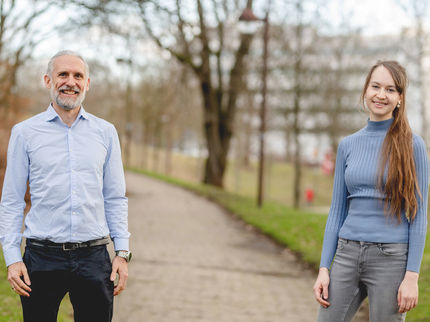New energy conversion layer for biosolar cells
Photosynthetic proteins can convert light energy into other forms of energy. Researchers want to make this technology usable for the industrial production of fuels, for example.

A bioelectrode with the protein complex Photosystem I under irradiation with red light for measurement of the photocurrent response
© Felipe Conzuelo
A research team from the Ruhr-Universität Bochum (RUB), together with colleagues from Lisbon, has produced a semi-artificial electrode that could convert light energy into other forms of energy in biosolar cells. The technique is based on the photosynthesis protein Photosystem I from cyanobacteria. The group showed that they could couple their system with an enzyme that used the converted light energy to produce hydrogen.
For the work, the RUB group consisting of Panpan Wang, Dr. Fangyuan Zhao, Dr. Julian Szczesny, Dr. Adrian Ruff, Dr. Felipe Conzuelo and Professor Wolfgang Schuhmann from the Center for Electrochemistry cooperated with the team consisting of Anna Frank, Professor Marc Nowaczyk and Professor Matthias Rögner from the Chair of Biochemistry of Plants as well as colleagues from the Universidade Nova de Lisboa.
Short-circuit danger
Photosystem I is part of the photosynthesis machinery in cyanobacteria and plants. With the help of light energy, it can separate charges and thus generate high-energy electrons that can be transferred to other molecules, for example to protons for the production of hydrogen.
In earlier work, the Bochum scientists had already used the light-collecting protein complex photosystem I to design electrodes for biosolar cells. For this purpose, they covered an electrode with a photosystem I monolayer. In such monolayers, the photosystems are not stacked on top of each other, but lie side by side in the same plane. Photosystem I, however, usually occurs as a trimer, i.e. three photosystems are always linked together. Since the trimers cannot be packed close together, holes appear in the monolayer, which can lead to short circuits. This impairs the performance of the system. It was precisely this problem that the scientists solved in the present work.
Holes in the photosystem layer plugged
In the cyanobacterium Thermosynechococcus elongatus, photosystem I exists mainly as a trimer. Using a new extraction technique, the researchers were able to isolate additionally monomers from the organism, creating a photosystem I monolayer on the electrode in which the monomers filled the holes between the trimers. In this way, they reduced the short-circuit effects. The system achieved current densities twice as high as a system consisting only of trimers.
To show what the technique could be in principle used for, the scientists coupled it to a hydrogenase enzyme that produced hydrogen using electrons provided by the photosystem. “Future work will be directed toward even more efficient coupling between the photosystem monolayer and the integrated biocatalysts to realize practical biosystems for solar energy conversion,” the authors preview in their publication.
Original publication
Other news from the department science

Get the life science industry in your inbox
By submitting this form you agree that LUMITOS AG will send you the newsletter(s) selected above by email. Your data will not be passed on to third parties. Your data will be stored and processed in accordance with our data protection regulations. LUMITOS may contact you by email for the purpose of advertising or market and opinion surveys. You can revoke your consent at any time without giving reasons to LUMITOS AG, Ernst-Augustin-Str. 2, 12489 Berlin, Germany or by e-mail at revoke@lumitos.com with effect for the future. In addition, each email contains a link to unsubscribe from the corresponding newsletter.
Most read news
More news from our other portals
Last viewed contents
Pharmacia
Antidepressant medication protects against compounds linked to dementia
Patrick_J._Kelly_(surgeon)
James_McGaugh
Beta-ketothiolase_deficiency
Glucocorticoid
George_Carlo






















































